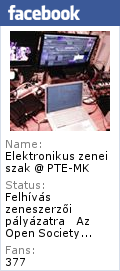Linkek:
- CMJ - Computer Music Journal / demó szám
- Leonardo / Leonardo Music Journal
- ICMC publikációs lista
- MTO - Music Theory Online (további zeneelméleti linkek at Other Theory-Related Journals szekcióban!)
- NIME - New Interfaces in Musical Expression (teljes szövegarchívum!) 2007 - 2006 (nincs archívum, francia szervezés...) - 2005 (videó is!) - 2004 - 2003 - 2002 - 2001
- Fibreculture Journal
- M/C Journal
- Egyéb szövegek privát gyűjtésből itt ill. egyben-zip-345Mb
Számítógépzenei taxonómia
Forrás: A Taxonomy of Computer Music - Editor'S Notes by Stephen Travis Pope
In: Computer Music Journal, Spring 1994, Vol. 18, Number 1., 5-7.
| Angol | Magyar | ||
| 1. Music theory, composition, and performance |
|
|
|
|
| 1.1. Music theory, sociology, and aesthetics |
|
|
|
|
| 1.1.1. Music theory and analysis |
|
|
|
| 1.1.2. Temperament and tuning systems |
|
|
|
| 1.1.3. New musical aesthetics and sociologies |
|
|
| 1.2. Composition of electro-acoustic music |
|
|
|
|
| 1.2.1. Sound and composition models and notations |
|
|
|
| 1.2.2. Models of the composition and performance processes |
|
|
|
| 1.2.3. Sound design and processiong |
|
|
|
| 1.2.4. Realization and production techniques |
|
|
|
| 1.2.5. Aural rendering, or sonification, of scientific data |
|
|
| 1.3. Algorithmic and computer-aided composition |
|
|
|
|
| 1.3.1. Compositional algorithms and languages |
|
|
|
| 1.3.2. Composition systems for score or sound synthesis |
|
|
|
| 1.3.3. Artificial intelligence and composition |
|
|
| 1.4. Performance situations and interfaces |
|
|
|
|
| 1.4.1. Performing and conducting |
|
|
|
| 1.4.2. Gesture recognition and interfaces |
|
|
|
| 1.4.3. Score following in performance |
|
|
|
| 1.4.4. Expression representation and analysis |
|
| 2. Musical acoustics, psychoacoustics, perception, and cognition |
|
|
|
|
| 2.1. Musical acoustics and psychoacoustics |
|
|
|
|
| 2.1.1. Acoustics of musical instruments and voice |
|
|
|
| 2.1.2. Psychoacoustics |
|
|
|
| 2.1.3. Room and spatial acoustics |
|
|
| 2.2. Music perception and psychology |
|
|
|
|
| 2.2.1. Physiology of hearing |
|
|
|
| 2.2.2. Pitch identification |
|
|
|
| 2.2.3. Rhythm identification |
|
|
|
| 2.2.4. Timbre perception |
|
|
| 2.3. Music understanding and cognition |
|
|
|
|
| 2.3.1. Rhythm understanding |
|
|
|
| 2.3.2. Key and scale recognition |
|
|
|
| 2.3.3. Higher-level structures |
|
| 3. Musical signal and event representation and notation |
|
|
|
|
| 3.1. Models of signals and events |
|
|
|
|
| 3.1.1. Language systems |
|
|
|
| 3.1.2. Encodings for file formats |
|
|
|
| 3.1.3. Graphical notation systems |
|
|
| 3.2. Musical event description languages |
|
|
|
|
| 3.2.1. Note-list formats |
|
|
|
| 3.2.2. Music input languages |
|
|
|
| 3.2.3. Music programming languages |
|
|
| 3.3. Musical signal description languages |
|
|
|
|
| 3.3.1. Signal models and descriptions |
|
|
|
| 3.3.2. Software synthesis languages |
|
|
| 3.4. Music notation and printing tools |
|
|
|
|
| 3.4.1. Transcription of performance |
|
|
|
| 3.4.2. Optical recognition of scores |
|
| 4. Digital control and sound signal synthesis and processing |
|
|
|
|
| 4.1. Sound synthesis methods |
|
|
|
|
| 4.1.1. Additive sound synthesis methods |
|
|
|
| 4.1.2. Subtractive sound synthesis methods |
|
|
|
| 4.1.3. Nonlinear sound synthesis methods |
|
|
|
| 4.1.4. Physical models of acoustical systems |
|
|
|
| 4.1.4.x. Various types of physical models |
|
|
|
| 4.1.5. Other synthesis methods |
|
|
|
| 4.1.6. Analysis and resynthesis systems |
|
|
| 4.2. Time- and frequency-domain signal processing |
|
|
|
|
| 4.2.1. Software architecture |
|
|
|
| 4.2.2. Time domain |
|
|
|
| 4.2.3. Frequency domain model synthesis |
|
|
|
| 4.2.4. Ad hoc synthesis techniques |
|
|
|
| 4.2.5. Effects and filters |
|
|
| 4.3. Sound spatialization and localization |
|
|
|
| 4.4. Machine recognition ofsignals and events |
|
|
|
| 4.5. Real-time processing and scheduling |
|
|
|
|
| 4.5.1. Real-time scheduling |
|
|
|
| 4.5.2. Real-time languages |
|
|
|
| 4.5.3. Hardware architectures |
|
|
| 4.6. MIDI and control processing |
|
|
| 5. Hardware for computer music instruments and tools |
|
|
|
|
| 5.1. Hardware for digital signal processing and digital audio |
|
|
|
| 5.2. Computer music workstations |
|
|
|
| 5.3. Input/output devices for music |
|
|
| 6. Computers in music education and computer music education |
|
|
|
|
| 6.1. Computers in music education |
|
|
|
| 6.2. Computer music education |
|
|
| 7. Computer music literature, history, and sources |
|
|
|
|
| 7.1. Bibliographies / diskographies |
|
|
|
| 7.2. Studio reports |
|
|
|
| 7.3. Descriptions of compositions |
|
|
|
| 7.4. History of electroacoustic music |
|
|
utoljára frissítve: 2008. március 03. 15:17:22
MK-MAMI
Elérhetőségünk:
PTE Művészeti Kar, Média- és Alkalmazott Művészetek Intézete
H-7630 Pécs, Zsolnay Vilmos u. 16.
tel/fax:+36(72)501540
e-mail: radnai.eva kukac art.pte.hu
Facebook-oldalaink:
- Kerámiatervezés:
PTE MAMI Kerámia Tanszék
Promote your Page too
- Elektronikus zenei szak:
Elektronikus zenei szak @ PTE-MK
- Tervezőgrafika szak: itt



